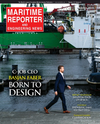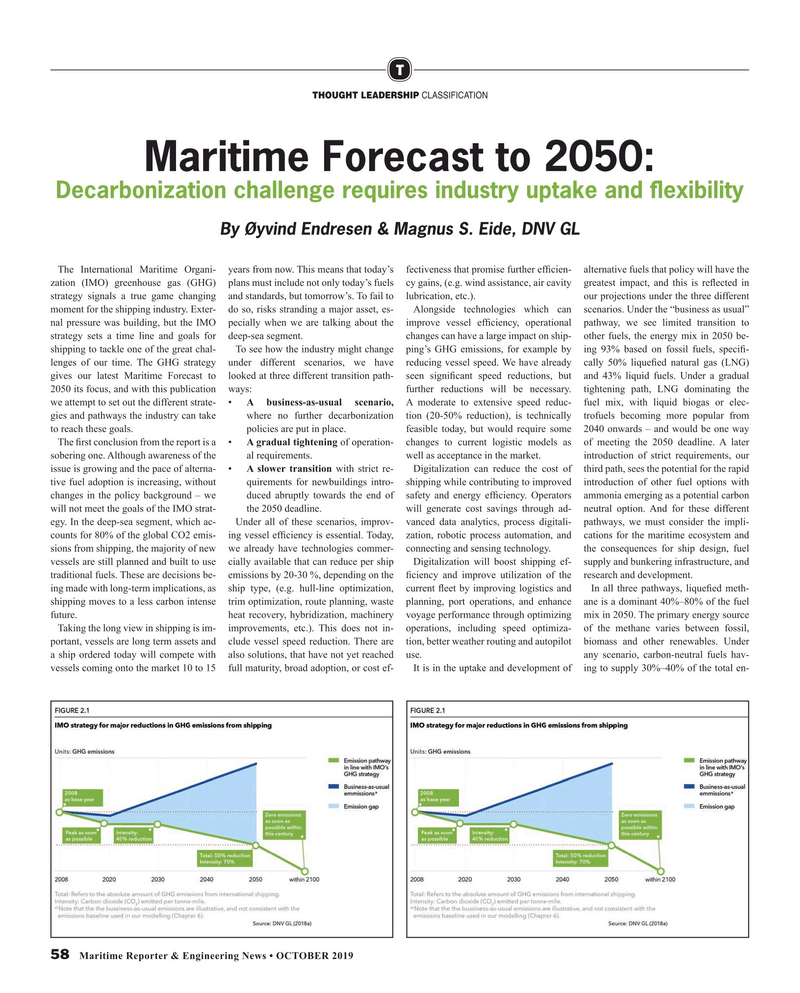
Page 58: of Maritime Reporter Magazine (October 2019)
Marine Design Annual
Read this page in Pdf, Flash or Html5 edition of October 2019 Maritime Reporter Magazine
T
THOUGHT LEADERSHIP CLASSIFICATION
Maritime Forecast to 2050:
Decarbonization challenge requires industry uptake and ? exibility
By Øyvind Endresen & Magnus S. Eide, DNV GL
The International Maritime Organi- years from now. This means that today’s fectiveness that promise further ef? cien- alternative fuels that policy will have the zation (IMO) greenhouse gas (GHG) plans must include not only today’s fuels cy gains, (e.g. wind assistance, air cavity greatest impact, and this is re? ected in strategy signals a true game changing and standards, but tomorrow’s. To fail to lubrication, etc.). our projections under the three different moment for the shipping industry. Exter- do so, risks stranding a major asset, es- Alongside technologies which can scenarios. Under the “business as usual” nal pressure was building, but the IMO pecially when we are talking about the improve vessel ef? ciency, operational pathway, we see limited transition to strategy sets a time line and goals for deep-sea segment. changes can have a large impact on ship- other fuels, the energy mix in 2050 be- shipping to tackle one of the great chal- To see how the industry might change ping’s GHG emissions, for example by ing 93% based on fossil fuels, speci? - lenges of our time. The GHG strategy under different scenarios, we have reducing vessel speed. We have already cally 50% lique? ed natural gas (LNG) gives our latest Maritime Forecast to looked at three different transition path- seen signi? cant speed reductions, but and 43% liquid fuels. Under a gradual 2050 its focus, and with this publication ways: further reductions will be necessary. tightening path, LNG dominating the we attempt to set out the different strate- • A business-as-usual scenario, A moderate to extensive speed reduc- fuel mix, with liquid biogas or elec- gies and pathways the industry can take where no further decarbonization tion (20-50% reduction), is technically trofuels becoming more popular from to reach these goals. policies are put in place. feasible today, but would require some 2040 onwards – and would be one way
The ? rst conclusion from the report is a • A gradual tightening of operation- changes to current logistic models as of meeting the 2050 deadline. A later sobering one. Although awareness of the al requirements. well as acceptance in the market. introduction of strict requirements, our issue is growing and the pace of alterna- • A slower transition with strict re- Digitalization can reduce the cost of third path, sees the potential for the rapid tive fuel adoption is increasing, without quirements for newbuildings intro- shipping while contributing to improved introduction of other fuel options with changes in the policy background – we duced abruptly towards the end of safety and energy ef? ciency. Operators ammonia emerging as a potential carbon will not meet the goals of the IMO strat- the 2050 deadline. will generate cost savings through ad- neutral option. And for these different egy. In the deep-sea segment, which ac- Under all of these scenarios, improv- vanced data analytics, process digitali- pathways, we must consider the impli- counts for 80% of the global CO2 emis- ing vessel ef? ciency is essential. Today, zation, robotic process automation, and cations for the maritime ecosystem and sions from shipping, the majority of new we already have technologies commer- connecting and sensing technology. the consequences for ship design, fuel vessels are still planned and built to use cially available that can reduce per ship Digitalization will boost shipping ef- supply and bunkering infrastructure, and traditional fuels. These are decisions be- emissions by 20-30 %, depending on the ? ciency and improve utilization of the research and development. ing made with long-term implications, as ship type, (e.g. hull-line optimization, current ? eet by improving logistics and In all three pathways, lique? ed meth- shipping moves to a less carbon intense trim optimization, route planning, waste planning, port operations, and enhance ane is a dominant 40%–80% of the fuel future. heat recovery, hybridization, machinery voyage performance through optimizing mix in 2050. The primary energy source
Taking the long view in shipping is im- improvements, etc.). This does not in- operations, including speed optimiza- of the methane varies between fossil, portant, vessels are long term assets and clude vessel speed reduction. There are tion, better weather routing and autopilot biomass and other renewables. Under a ship ordered today will compete with also solutions, that have not yet reached use. any scenario, carbon-neutral fuels hav- vessels coming onto the market 10 to 15 full maturity, broad adoption, or cost ef- It is in the uptake and development of ing to supply 30%–40% of the total en- 58 Maritime Reporter & Engineering News • OCTOBER 2019
MR #10 (59-65).indd 58 10/7/2019 9:58:23 AM

 57
57

 59
59
